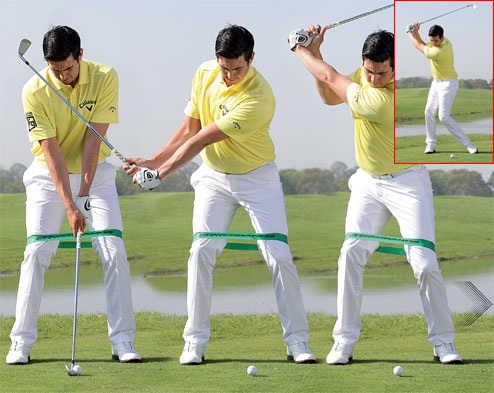Maintaining balance during your golf swing is crucial for achieving a consistent and effective shot. Although it may seem challenging at first, there are simple techniques that can improve your balance and overall performance on the golf course. By focusing on your posture, foot placement, and weight distribution, you will be able to stay steady and develop a smooth swing that maximizes power and accuracy. In this article, we will explore some helpful tips and strategies to help you maintain balance during your golf swing, so you can confidently step up to the tee and hit that perfect shot.
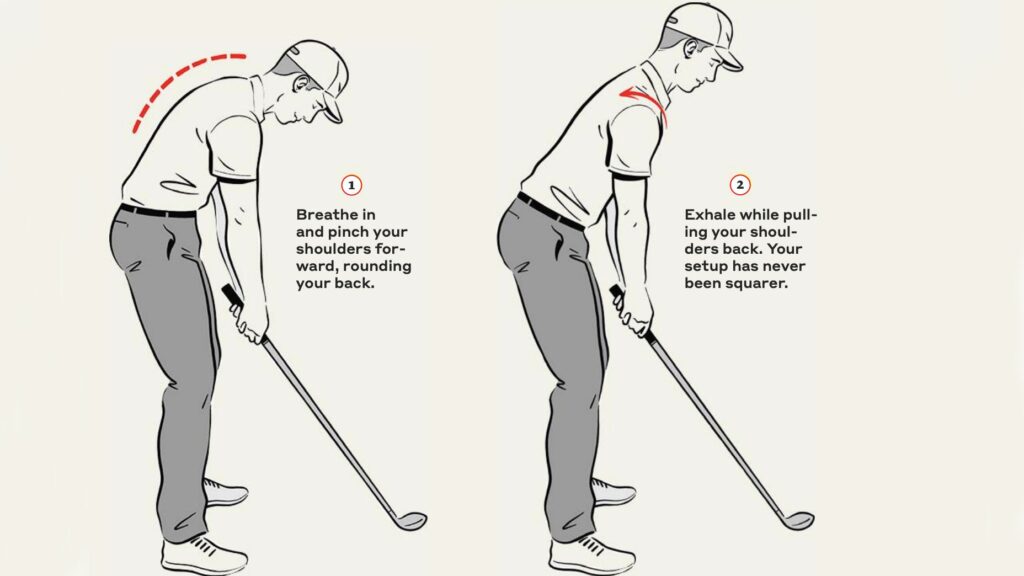
Understanding the Importance of Balance in Golf Swing
Golf is a sport that requires precision and finesse, and a crucial element in achieving a successful golf swing is balance. Balance is the foundation of any athletic movement, and without it, your swing can become inconsistent and unpredictable. The ability to maintain balance throughout your swing is essential for generating power, accuracy, and distance. In this article, we will delve into why balance is important, the impact it has on swing efficiency, and how it affects both distance and accuracy. We will also explore various factors that influence balance in the golf swing, exercises to improve balance, techniques to maintain balance, common mistakes to avoid, the role of equipment, the mental aspect of balance, the importance of flexibility and strength, and seeking professional guidance to enhance your balance skills.
Why is balance important?
Balance is the key to a successful golf swing because it allows you to transfer weight properly, maintain a stable base, and generate power efficiently. Without balance, your swing may lack stability, resulting in inconsistency and reduced performance. By achieving and maintaining proper balance throughout your swing, you can enhance your control, accuracy, and distance, ultimately improving your overall golf game.
The impact of balance on swing efficiency
Maintaining balance during your golf swing is crucial for maximizing efficiency. When your body is balanced, you can transfer weight from one side to the other smoothly, allowing for a more fluid and powerful swing. On the other hand, if your balance is compromised, your weight transfer may become unstable, making it challenging to generate power and control the direction of your shots. By focusing on balance, you can optimize the efficiency of your swing, resulting in improved performance on the golf course.
How balance affects distance and accuracy
Balance plays a significant role in both the distance and accuracy of your shots. When you are in balance, you can apply maximum force to the ball, resulting in increased distance. Additionally, balance allows you to maintain control over the clubhead, enabling you to achieve greater accuracy in your shots. Whether you are aiming for distance or accuracy, developing good balance in your golf swing is essential for achieving both.
Factors Influencing Balance in Golf Swing
Several factors influence balance in your golf swing, and understanding and addressing these factors can greatly enhance your performance on the course. Let’s take a closer look at three key factors: body alignment and posture, weight distribution, and foot placement and stance width.
Body alignment and posture
Proper alignment and posture are fundamental to maintaining balance in your golf swing. When addressing the ball, it is crucial to align your feet, hips, and shoulders parallel to the target line. This alignment creates a solid and stable foundation, allowing for a more balanced and controlled swing. Additionally, maintaining good posture throughout your swing is essential for balance. By keeping your spine straight and your weight centered, you can optimize your balance and improve your swing mechanics.
Weight distribution
Weight distribution refers to the distribution of your bodyweight between your feet during the different phases of your golf swing. To maintain balance, it is important to have a proper weight distribution. At address, your weight should be evenly distributed between both feet, creating a stable base. As you initiate your backswing, you can shift your weight slightly towards your back foot, loading your power into the ground. During your downswing and follow-through, your weight should transfer smoothly from your back foot to your front foot, allowing for a balanced and powerful swing.
Foot placement and stance width
The positioning of your feet and the width of your stance have a significant impact on your balance during your golf swing. Your feet should be shoulder-width apart, providing a stable foundation. Additionally, your lead foot (left foot for right-handed golfers) should be slightly flared open to accommodate the rotational movement of your hips during the swing. Finding the optimal foot placement and stance width that feels comfortable and balanced for you is crucial for maintaining stability and control throughout your swing.
Exercises to Improve Balance in Golf Swing
Improving your balance in your golf swing requires practice and targeted exercises that challenge your stability and coordination. Here are three exercises specifically designed to enhance your balance:
Single-leg balance exercises
Single-leg balance exercises are a great way to improve your stability and strengthen the muscles that support your balance. Stand on one leg and hold the position for 30 seconds, gradually increasing the duration as you get more comfortable. To make the exercise more challenging, try closing your eyes or incorporating small movements, such as raising your other leg to the side or extending it forward.
Balance board drills
Balance boards are excellent tools for improving balance in your golf swing. By standing on a balance board, you engage your core muscles and challenge your stability. Start by standing on the balance board with your feet shoulder-width apart and attempt to maintain your balance as the board tilts in different directions. As you progress, you can incorporate golf-specific movements, such as mimicking your swing motion while balancing on the board.
Yoga and Pilates for stability
Practicing yoga or Pilates can greatly enhance your stability and balance in your golf swing. Both disciplines focus on core strength, flexibility, and body awareness, which are all crucial for maintaining balance throughout your swing. Incorporating yoga or Pilates into your regular exercise routine can help improve your body control, stability, and overall performance on the golf course.
Techniques to Maintain Balance During Golf Swing
Maintaining balance during your golf swing involves a combination of techniques that promote stability and a smooth weight transfer. Let’s explore three key techniques: maintaining a stable base, proper weight transfer, and swing tempo and rhythm.
Maintaining a stable base
A stable base is essential for maintaining balance throughout your swing. To achieve a stable base, ensure that your feet are grounded firmly and evenly. Avoid excessive movement or shifting of your feet during your swing, as this can lead to loss of balance. By maintaining a solid base, you can create a foundation for a balanced and powerful swing.
Proper weight transfer
Weight transfer is a crucial element in maintaining balance during your golf swing. As you initiate your backswing, shift your weight slightly towards your back foot while maintaining a stable base. During your downswing and follow-through, smoothly transfer your weight from your back foot to your front foot, allowing for a balanced and powerful swing. Avoid any sudden or jerky weight shifts, as these can disrupt your balance and compromise the effectiveness of your swing.
Swing tempo and rhythm
The tempo and rhythm of your swing can greatly impact your balance. By maintaining a smooth and consistent tempo throughout your swing, you can enhance your balance and control. Rushed or fast swings can throw off your balance, leading to inconsistent shots. Focus on maintaining a tempo that feels comfortable and allows you to maintain a steady rhythm, ensuring improved balance and overall performance.
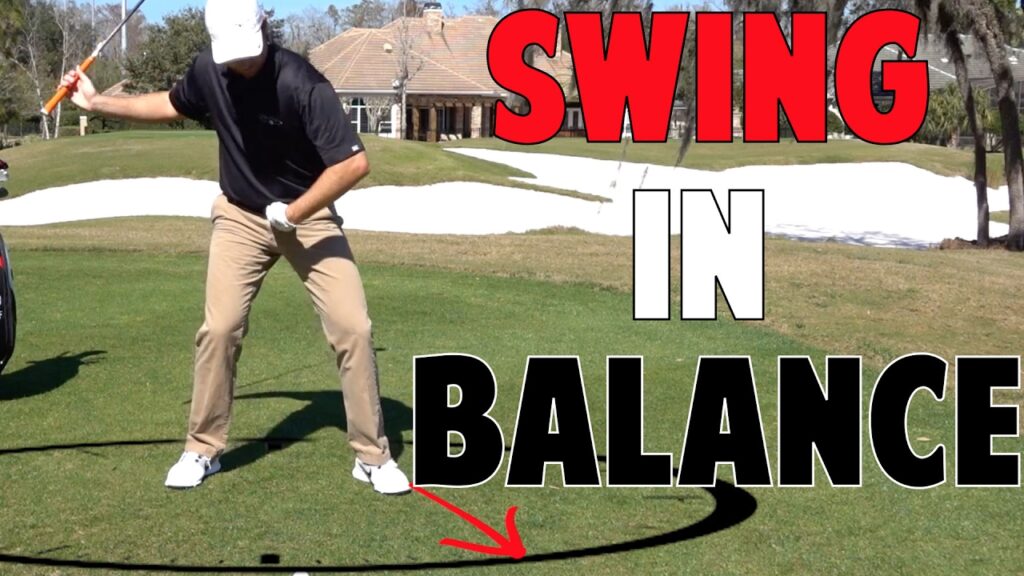
Drills and Tips for Better Balance in Golf Swing
In addition to exercises and techniques, specific drills and tips can further improve your balance in your golf swing. Let’s explore three effective drills and tips: balancing on one foot at address, swinging with eyes closed, and focusing on a fixed point.
Balancing on one foot at address
Practicing balance at address can greatly enhance your stability and control throughout your swing. During your practice sessions, try balancing on one foot at the address position, holding the position for a few seconds before switching to the other foot. This drill challenges your stability and strengthens the muscles that support your balance, ultimately improving your overall swing performance.
Swinging with eyes closed
Swinging with your eyes closed is a valuable drill to develop a greater sense of body awareness and balance. By removing visual distractions, you can focus more on the feeling of your swing and the movements of your body. This drill trains your proprioception, or your body’s ability to sense its position and movements. Start with slow swings and gradually increase the speed as you become more comfortable and confident in your balance.
Focusing on a fixed point
During your swing, fixating your eyes on a specific point can help improve your balance and control. Choose a spot on the ground or an object in the distance, and maintain your focus on it throughout your swing. This technique can help steady your head position and prevent any unnecessary head movement, promoting better balance and a more consistent swing.
Common Balance Mistakes to Avoid in Golf Swing
When it comes to balance in your golf swing, there are several common mistakes to be aware of and avoid. By being mindful of these mistakes, you can improve your balance and enhance your overall swing performance. Let’s examine three common balance mistakes: leaning excessively in any direction, not engaging core muscles, and swinging too hard.
Leaning excessively in any direction
Leaning excessively in any direction during your swing can disrupt your balance and lead to inconsistent shots. Leaning too far forward can cause you to lose power, while leaning too far back can result in a lack of control and accuracy. Maintain an upright posture and avoid excessive leaning or swaying throughout your swing to maintain proper balance.
Not engaging core muscles
Engaging your core muscles is key to maintaining balance during your golf swing. A strong core provides stability throughout the swing and allows for a smoother weight transfer. Neglecting to engage your core can lead to a lack of balance and control. Incorporate core-strengthening exercises into your fitness routine to develop a solid foundation and enhance your overall stability in your swing.
Swinging too hard
Swinging too hard in an attempt to generate extra power can throw off your balance and compromise the effectiveness of your swing. A controlled and balanced swing is more valuable than raw power alone. Focus on maintaining a smooth and controlled tempo, allowing for a balanced weight transfer and improved overall swing performance.
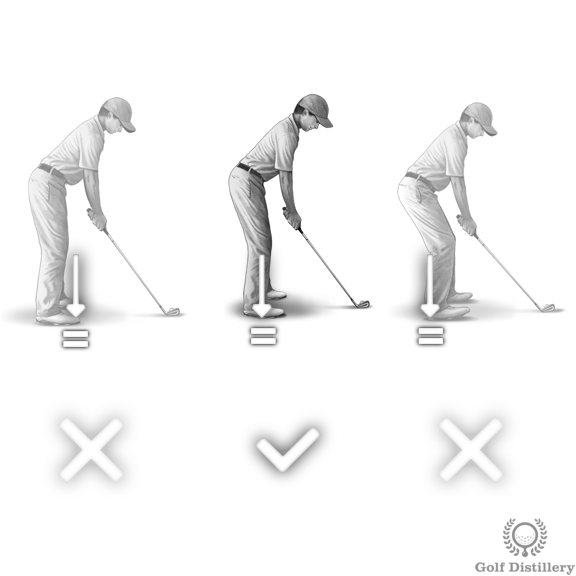
The Role of Equipment in Balancing Golf Swing
In addition to technique and physical conditioning, the equipment you use can also play a role in balancing your golf swing. From choosing the right golf shoes to using a properly fitted golf club and understanding grip pressure, let’s explore the equipment-related aspects that contribute to balance.
Choosing the right golf shoes
Proper footwear is essential for maintaining balance and stability during your golf swing. Opt for golf shoes that provide excellent traction and support. The shoes should fit well, providing a snug yet comfortable feel. With the right golf shoes, you can ensure that your feet stay grounded, allowing for better stability and balance throughout your swing.
Using a properly fitted golf club
Using a golf club that is properly fitted to your body and swing characteristics can greatly enhance your balance. A club that is too long or too short can affect your body alignment and throw off your balance. Additionally, the weight, flex, and grip size of the club should be suited to your individual needs. Working with a professional club fitter can help you find the ideal club specifications for improved balance and overall swing performance.
Understanding grip pressure
Grip pressure directly impacts your balance and control during your golf swing. Holding the club too tightly can cause tension in your hands, arms, and upper body, leading to a loss of balance and restricted movement. On the other hand, gripping the club too lightly can result in a lack of control. Finding the right balance of grip pressure is crucial. Aim for a firm yet relaxed grip, allowing for a free and fluid swing while maintaining control and balance.
The Mental Aspect of Maintaining Balance
While balance in your golf swing is influenced by physical factors, the mental aspect also plays a significant role. Maintaining focus, managing nerves and stress, and utilizing visualization techniques are all essential for enhancing your balance on the course.
Staying focused and concentrated
Being mentally present and fully focused during your swing is vital for maintaining balance. Clear your mind of distractions, take deep breaths to center yourself, and visualize the intended outcome of your swing. By staying focused and concentrating on the task at hand, you can enhance your balance and perform at your best.
Managing nerves and stress
Managing nerves and stress is a crucial aspect of maintaining balance in your golf swing. Feeling anxious or tense can disrupt your balance and lead to inconsistent shots. Take time to relax before your swing, develop pre-shot routines to calm your nerves, and trust in your abilities. By managing nerves and stress effectively, you can maintain balance and perform under pressure.
Visualization techniques
Visualization is a powerful technique that can positively impact your balance and overall performance. Before your swing, visualize yourself executing a balanced and smooth swing, hitting the perfect shot. This mental rehearsal can help program your mind and body for success, enhancing your focus and balance during the actual swing.
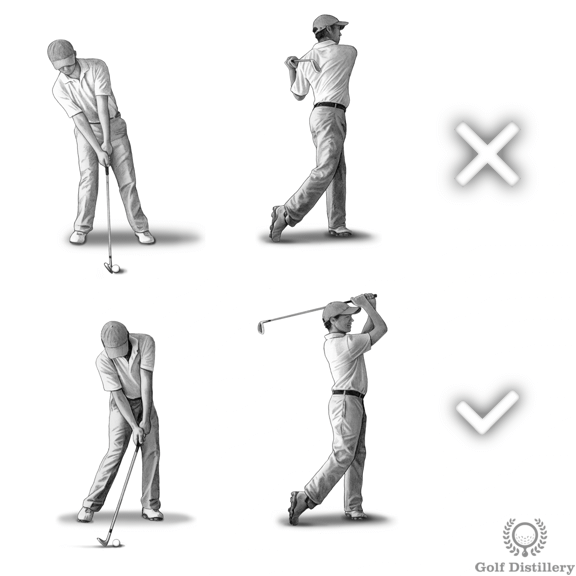
Importance of Flexibility and Strength for Balance
Flexibility and strength play integral roles in maintaining balance during your golf swing. By improving your flexibility, you can achieve a wider range of motion, allowing for better weight transfer and balance. Additionally, building strength in your core and lower body muscles helps stabilize your body during your swing. Let’s explore the importance of flexibility and strength in more detail.
Stretching exercises for improved flexibility
Incorporating stretching exercises into your routine can significantly improve your flexibility and promote better balance in your golf swing. Focus on stretches that target your hips, shoulders, back, and hamstrings. Stretching before and after your practice sessions or rounds can help increase your range of motion, allowing for a smoother and more balanced swing.
Exercises to strengthen core and lower body
A strong core and lower body are essential for maintaining balance and stability during your golf swing. Engaging in exercises that target these areas, such as planks, squats, lunges, and rotational exercises, can help strengthen the muscles involved in balance and weight transfer. By building strength in your core and lower body, you can enhance your overall stability and balance, leading to improved swing performance.
The role of physical fitness in maintaining balance
Overall physical fitness plays a vital role in maintaining balance throughout your golf swing. Engaging in regular cardiovascular exercise, strength training, and flexibility routines helps improve your overall athleticism, coordination, and body control. By prioritizing your physical fitness and incorporating a well-rounded exercise regimen into your routine, you can enhance your balance, stamina, and performance on the golf course.
Seeking Professional Guidance to Improve Balance
Seeking professional guidance can be highly beneficial in improving your balance and overall golf swing. Golf instructors and physical therapists can provide valuable insights, personalized training plans, and feedback to enhance your balance skills. Let’s explore three avenues for seeking professional guidance: working with a golf instructor, physical therapy, and customizing a training plan.
Working with a golf instructor
A golf instructor can offer professional guidance tailored to your specific needs and goals. They can analyze your swing, identify areas for improvement, and provide drills and exercises to enhance your balance. The expertise and guidance of a golf instructor can make a significant difference in refining your technique and optimizing your balance on the course.
Physical therapy for balance improvement
If you are struggling with balance issues in your golf swing, seeking assistance from a physical therapist specializing in sports performance can be beneficial. A physical therapist can evaluate your movement patterns and provide targeted exercises and treatments to address any underlying physical limitations that may be affecting your balance. By working with a physical therapist, you can enhance your balance, reduce the risk of injury, and improve your overall performance on the golf course.
Customizing a training plan
To optimize your balance in your golf swing, customizing a training plan specific to your needs can be highly effective. This may involve combining elements from various disciplines, such as golf-specific exercises, yoga, strength training, and cardiovascular conditioning. By working with a certified trainer or coach, you can create a comprehensive training plan that addresses your balance, flexibility, strength, and overall physical fitness, ultimately improving your performance on the golf course.
In conclusion, balance is a fundamental aspect of the golf swing that significantly impacts your performance on the course. Achieving and maintaining balance allows for better weight transfer, improved control, increased distance, and enhanced accuracy. By understanding the factors influencing balance, engaging in targeted exercises, implementing effective techniques, avoiding common mistakes, utilizing appropriate equipment, nurturing the mental aspect, and prioritizing flexibility and strength, you can enhance your balance and elevate your overall golf game. Seeking professional guidance can provide valuable insights and personalized assistance to further improve your balance skills. So, go out there, practice your balance, and enjoy the benefits of a more consistent and effective golf swing!
